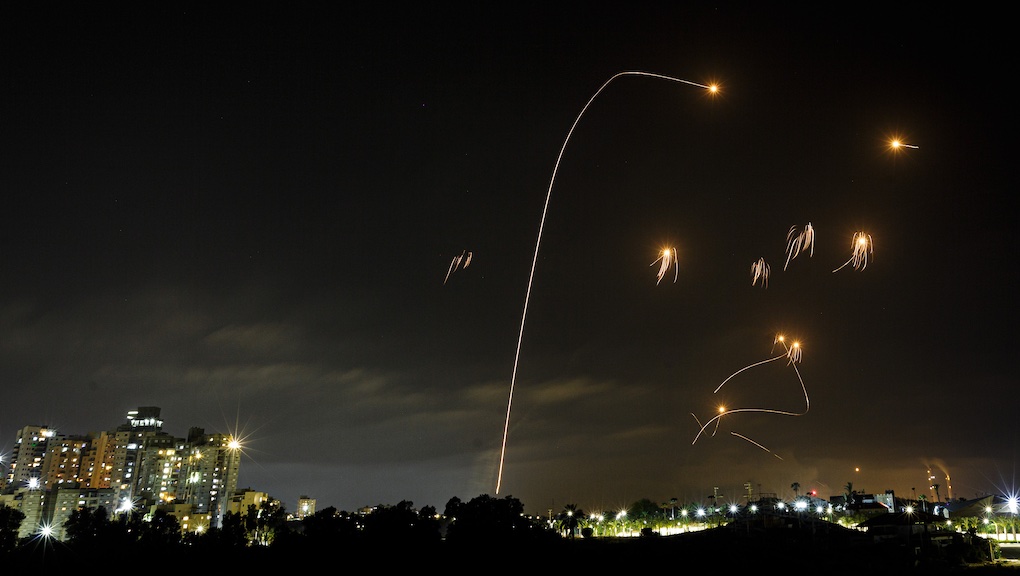Israel continues to defend itself against Iran
The Fourth Gaza War is now more than 10 days old and fighting continues unabated with Hamas continuing to pummel Israel with its rockets and the IDF conducting an extensive campaign against Hamas’ military infrastructure and its underground tunnel city. There’s much speculation about an imminent ceasefire but both sides deny that this could be the case anytime soon.
The war started after Israel refused to withdraw its security forces from the Temple Mount and re-open the Damascus Gate Square in Jerusalem. The square was closed after violent riots that lasted for days.
On Monday morning 10th May Palestinian Arabs again violently clashed with Israeli security forces and during the skirmishes at least 395 of them were injured. Hamas leaders reportedly watched the video footage of this bloody riot and then issued an ultimatum to Israel. Israel had to withdraw its security forces from the Temple Mount without further delay. However, the government in Jerusalem refused because it doesn’t take ultimatums from Hamas and considers itself the legitimate power in Jerusalem.
The Iranian-backed Sunni terror organization then launched rockets at Jerusalem which triggered a harsh Israeli response. In the ensuing hours, the Israeli air force (IAF) started to bomb some Hamas facilities in Gaza whereafter the Palestinian terror organizations in the coastal strip shot at least 200 rockets at southern Israel.
The Fourth Gaza War had begun but this one would differ from the previous three ones.
First of all, Hamas and Palestinian Islamic Jihad appeared to be in the possession of ultra-modern weaponry and used different tactics than they did in the past.
For example, the two terror groups launched rockets in salvo’s a tactic that apparently was meant to ‘mislead’ the Iron Dome anti-missile shield. Indeed, Iron Dome proved to be far less effective than in the previous wars between Israel and the Gaza-based terror groups. There were many direct hits in several Israeli cities causing the death of at least ten people. Another number of rockets landed in parks, roads, and other places in these cities.
Another new tactic used by the two terror groups was inciting the Arab Israeli population which resulted in massive and very violent protests against the Israeli security forces and in numerous brutal attacks on Jewish Israelis or Jewish-owned property.
Prime Minister Benyamin Netanyahu recognized what was going on and told the public that Israel was “fighting on two fronts”.
Hamas and Palestinian Islamic Jihad (PIJ) also introduced new weapons such as a kamikaze drone. This unmanned aerial vehicle can carry a payload that explodes when it hits its target. The Israeli military intercepted one at the beginning of the war.
Then there was the Cornet anti-tank missile, a deadly weapon also in use by Hezbollah in Lebanon. Both Hamas and PIJ used the Iranian-supplied Cornet missile several times during the current war and this resulted in the death of at least two Israelis, one of them an IDF soldier.
Hamas also used a new type of rocket named Ayyash. The missile has a range of 250 kilometers and Hamas used it to stop flights to Israel when it shot the Ayyash in the direction of Ben Gurion Airport and the new Ramon Airport in the vicinity of Eilat.
Israel seemed to realize that all these changes on the Palestinian side required a different approach because this war could be the testing ground for a much bigger conflict in the future. For this reason the Israeli military bombed the military- and more civil infrastructure of Hamas and PIJ to smithereens and also tried to assassinate as many commanders of the two organizations as possible.
The Israel Defense Forces (IDF) and the Israeli air force (IAF) also introduced a new tactic never seen in the history of war.
Israel knew that Hamas, with Iranian help and funding, had created an underground city where it stored weapons and that was in use as a bunker for Hamas operatives in case of war or other emergencies.
At the same time, the IDF didn’t want to make the same fault as in 2014 when it lost soldiers during operations inside Gaza trying to blow up terror tunnels.
Thus the Israeli military used very different methods to destroy what it calls “the Metro” Hamas’ reinforced underground tunnel network.
After four days of fighting, some 160 warplanes and assault helicopters conducted simultaneously a massive attack on the tunnels in the northern Gaza Strip. The aircraft used 450 missiles and dropped 80 tons of explosives on the tunnel complex according to the IDF. The whole operation took a little more than 40 minutes and has reportedly killed hundreds of terrorists.
A similar operation was later used to destroy another stretch of the ‘Metro’ complex
Israel knows that the improved skills and weapons of Hamas and PIJ are the result of the Iranian involvement in Gaza.
How do we know?
Hamas leaders as well as PIJ officials talked about it openly, most recently Ramez al-Halabi one of the leaders of PIJ. Al-Halabi said during an interview with al-Ahd TV in Iraq that his organization gets its weapons, money, and even food from the Islamic Revolutionary Guards Corps in Iran.
The Telegraph in the United Kingdom, citing unnamed intelligence officials, confirmed that Iran is helping Hamas in all sorts of ways to improve its military capabilities and especially when it comes to the manufacturing of missiles.
So, the bigger picture of this latest Gaza War is that Israel is not only fighting two Palestinian terror groups.
The real battle here is against Iran that has vowed to destroy the Jewish state and is trying to do this in different ways. It is done by supplying Hamas with rockets, providing assistance to its proxies in Israel and by stirring up unrest among Palestinian Arabs living in Judea and Samaria as well as among Israeli Arabs. In addition, Iran – via Hezbollah- has been caught trying to create new terror groups in Judea and Samaria as well as in northern Israel.





